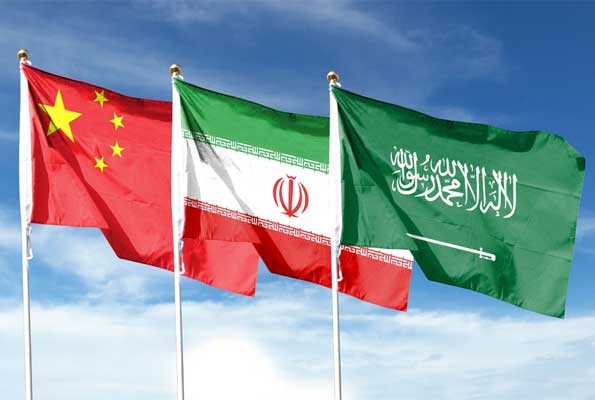The ‘2023 Beijing Accord’ to normalize Iran-Saudi relations may become a historical moment, just like in Bangkok in 1967, when Thailand’s foreign minister helped cease Indonesia-Malaysia hostilities. It’s important to remember that the Bangkok summit also birthed ASEAN, one of the world’s most successful regional organizations globally.
By the late 1960s, Southeast Asian republics realized they needed collaboration to prosper economically. They could hardly defend themselves, especially from a surging China. Transformative events in the area and the world were equally crucial in ASEAN’s establishment.
Recent de-escalations imply the Middle East is adopting Southeast Asia’s 1960s regional consciousness. Iran-Saudi Arabia talks began in Baghdad in April 2021, and ended in Beijing with a sustainable deal. The ‘Abraham Accords’ and the Turkey-Egypt reconciliation also signal normalization.
The Middle East is currently forming arrangements based on its national interests rather than those of outsiders. The region’s great power rivalry spurred this independence. Due to increased rivalry, regional powers have more options and are more independent of global management.
Israel and Saudi Arabia are deviating from the US on energy policy and the Ukraine war. Iran, which supplied drones to Russia, feels more confident about this development.
While the US is not leaving the Middle East, its Persian Gulf allies doubt its security guarantees and partnership. This brings them closer to Iran. The 2019 drone assaults on Aramco-owned oil facilities were the final straw for Saudi.
While the Donald Trump administration did not respond to these strikes, the 1980 Carter Doctrine, which pledged US action to preserve its Persian Gulf interests, expired for the Saudis. This likely encouraged the Saudis to negotiate with Iran. By 2021, the UAE and Oman were also expanding their Iran talks.
Washington believes the Middle East cannot be stable without US intervention. Regional powers must lead stabilization in the current situation. As these recent dialogues show, a regional consensus is emerging that zonal stabilization requires regional cooperation, with or without the US.
Beijing rejects the US strategy of offshore balancing against Iran via Saudi Arabia and Israel and deems it escalatory. Instead, China is neutralizing regional problems to reduce tensions.
Iranian sources have noted China’s growing regional stabilizing role. After Iran attacked Saudi petroleum assets in 2019, China warned Tehran that such actions hurt its interests because Beijing’s energy security policy relies on unrestricted imports of Saudi and Gulf oil.
Beijing is Iran and Saudi Arabia’s biggest trading partner, while Chinese-Saudi trade is six times larger. China’s energy security depends on preventing a war between Tehran and Riyadh, as half of its oil comes from the Persian Gulf. China may have the power and political will to help Iran and Saudi Arabia achieve economic unification.
China’s Middle East diplomacy may spur a counter from Washington. China’s actions may have prompted Iran and the US to discuss an informal nuclear pact. The White House must now fight the image of China as a peacemaker and the US as an aggressor that wants to sell weapons to the Middle East.
If China can pressure Tehran to persuade the Yemeni Houthis to negotiate a political arrangement with Saudi Arabia, Riyadh will win. If the Iranians retaliate, Riyadh can demonstrate to Beijing that they are not serious about de-escalation.
The diplomatic resumption also protects Riyadh from Iranian reprisal in the case of a military clash between Iran and the US or Israel.
This accord with Riyadh may temporarily distance Saudi Arabia from Israel, in a triumph for Tehran. More importantly, the pact might usher in a “cold peace” period between Tehran and Riyadh, during which neither party meddles in the other’s affairs. Saudi Foreign Minister Faisal bin Farhan Al Saud visited Tehran on June 17 to reiterate this vow of non-interference, which both sides value.
Crown Prince Mohammad bin Salman wants to reform Saudi society. Riyadh’s leadership believes economic development at home, particularly the crown prince’s ‘Vision 2030’ platform, is the greatest national strategy for the country’s future.
The accession of conservative Iranian President Ebrahim Raisi may have also brought Tehran and Riyadh closer. After Hassan Rouhani’s pragmatic government left in 2021, the Saudis faced a hardline Iranian regime. Meanwhile, Tehran’s hardliners were under pressure to produce. Since Tehran’s regional agenda was in the hands of the hardline Revolutionary Guard Corps, Iran’s ability to keep its promises, especially on regional policy, increased.
Tehran saw no way out of its impasse with Washington. Instead, it may change its attitude toward Arab rivals to avoid US penalties. Tehran policymakers grasped the value of immediate neighbours as global economic conduits.
Thus, the UAE, Iraq, and Oman have become Iran’s major commercial partners. Since the September 2022 protests over the death of Mahsa Amini in regime custody, Tehran hopes détente with Riyadh will reduce Saudi’s anti-Iran actions.
Tehran has power succession. Raisi is lucky that 84-year-old Supreme Leader Ali Khamenei’s program matches his political needs for now.
The Abraham Accords and Iran-Saudi reconciliation may complement or contradict. The ‘Abraham Accords’ may coincide with the Saudi-Iran thaw, but Israel and Iran are unlikely to cooperate. China’s neutrality may allow this. The ‘Abraham Accords’ could serve as a bridge between the two efforts if Saudi Arabia joins.



